O.S. Engines FS-70 User Manual
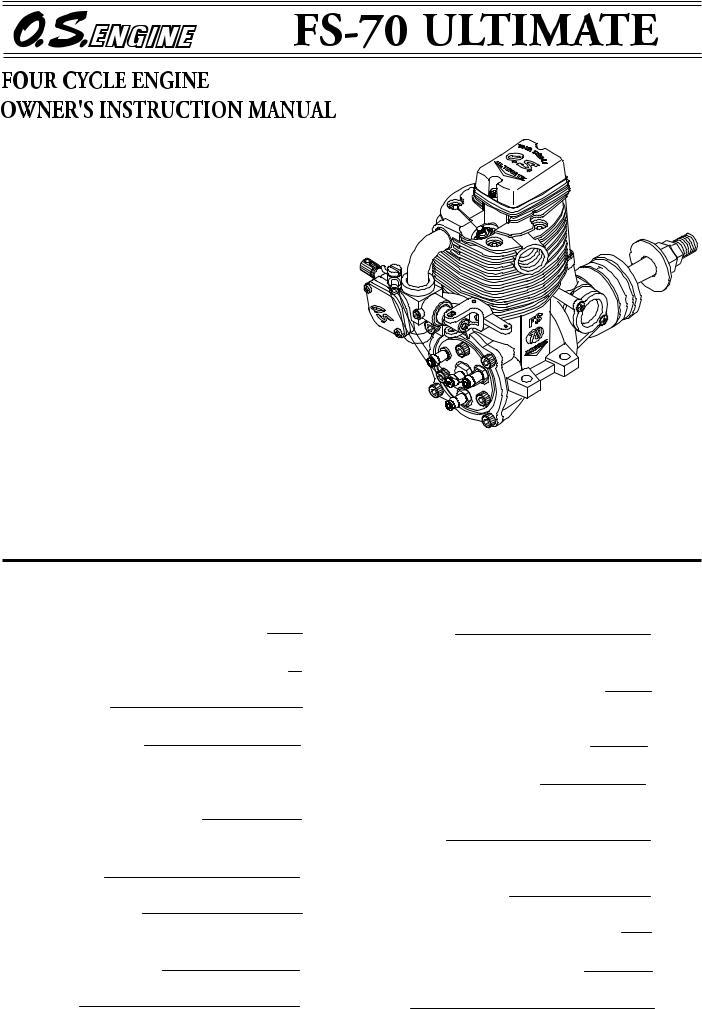
It is of vital importance, before attempting to operate your engine, to read the general
'SAFETY INSTRUCTIONS AND WARNINGS' section on pages 2-4 of this booklet and to strictly adhere to the advice contained therein.
 Also, please study the entire contents of this instruction manual, so as to familiarize yourself with the controls and other features of the engine.
Also, please study the entire contents of this instruction manual, so as to familiarize yourself with the controls and other features of the engine.
 Keep these instructions in a safe place so that you may readily refer to them whenever necessary.
Keep these instructions in a safe place so that you may readily refer to them whenever necessary.
 It is suggested that any instructions supplied with the aircraft, radio control equipment, etc., are accessible for checking at the same time.
It is suggested that any instructions supplied with the aircraft, radio control equipment, etc., are accessible for checking at the same time.
CONTENTS
SAFETY INSTRUCTIONS AND |
|
|
|
WARNINGS ABOUT YOUR O.S. ENGINE |
2-4 |
RUNNING-IN |
13-14 |
INTRODUCTION, INSTALLING THE GLOWPLUG |
5 |
IDLE MIXTURE ADJUSTMENT |
|
|
|
CARE AND MAINTENANCE (laying up) |
15 |
INSTALLATION |
6 |
|
|
|
|
VALVE ADJUSTING |
|
|
|
|
|
FUEL TANK & LINES |
7-8 |
HOW TO SET THE CAMSHAFT TIMING |
16-17 |
EXHAUST HEADER PIPE AND SILENCER, |
|
CARE AND MAINTENANCE |
18 |
THROTTLE LINKAGE, |
|
|
|
NEEDLE-VALVE EXTENSION |
9 |
CARBURETOR EXPLODED VIEWS & |
|
|
|
PARTS LIST |
19 |
CARE OF FUEL PUMP AND REGULATOR, |
|
|
|
PROPELLERS |
10 |
ENGINE EXPLODED VIEWS & |
|
|
|
ENGINE PARTS LISTS |
20-21 |
GLOWPLUGS, FUEL |
11 |
|
|
|
|
O.S. GENUINE PARTS & ACCESSORIES |
22 |
PROPELLER AND SPINNER ATTACHMENT, |
|
|
|
TYPE 60U CARBURETOR |
12 |
ENGINE THREE VIEW DRAWINGS |
23 |
STARTING |
13 |
MEMO |
24 |
1
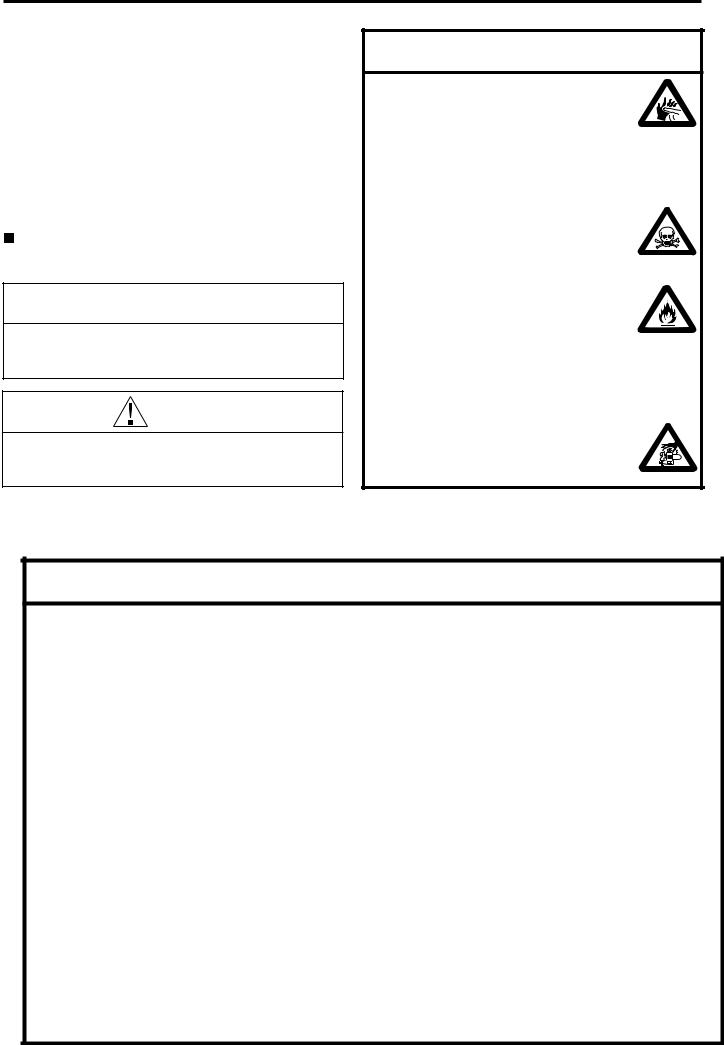
SAFETY INSTRUCTIONS AND WARNINGS ABOUT YOUR O.S. ENGINE
Remember that your engine is not a " toy ", but a highly efficient internal-combustion machine whose power is capable of harming you, or others, if it is misused or abused. As owner, you, alone, are responsible for the safe operation of your engine, so act with discretion and care at all times.
If at some future date, your O.S. engine is acquired by another person, we would respectfully request that these instructions are also passed on to its new owner.
The advice which follows is grouped under two headings according to the degree of damage or danger which might arise through misuse or neglect.
 WARNINGS
WARNINGS
These cover events which might involve serious ( in extreme circumstances, even fatal ) injury.
NOTES
These cover the many other possibilities, generally less obvious sources of danger, but which, under certain circumstances, may also cause damage or injury.
 WARNINGS
WARNINGS
 Never touch, or allow any object to come into contact with, the rotating propeller and do not crouch over the engine when it is running.
Never touch, or allow any object to come into contact with, the rotating propeller and do not crouch over the engine when it is running.
 A weakened or loose propeller may disintegrate or be thrown off and, since propeller tip speeds with powerful engines may exceed 600 feet(180 metres) per second, it will be understood that such a failure could result in serious injury, (see 'NOTES' section relating to propeller safety).
A weakened or loose propeller may disintegrate or be thrown off and, since propeller tip speeds with powerful engines may exceed 600 feet(180 metres) per second, it will be understood that such a failure could result in serious injury, (see 'NOTES' section relating to propeller safety).
 Model engine fuel is poisonous. Do not allow it to come into contact with the eyes or mouth. Always store it in a clearly marked container and out of the reach of children.
Model engine fuel is poisonous. Do not allow it to come into contact with the eyes or mouth. Always store it in a clearly marked container and out of the reach of children.
 Model engine fuel is also highly flammable. Keep it away from an open flame, excessive heat, sources of sparks, or anything else which might ignite it.
Model engine fuel is also highly flammable. Keep it away from an open flame, excessive heat, sources of sparks, or anything else which might ignite it.
Do not smoke or allow anyone else to smoke, near to it.
 Never operate your engine in an enclosed space. Model engines, like automobile engines, exhaust deadly carbonmonoxide. Run your engine only in an open area.
Never operate your engine in an enclosed space. Model engines, like automobile engines, exhaust deadly carbonmonoxide. Run your engine only in an open area.
 Model engines generate considerable heat. Do not touch any part of your engine until it has cooled. Contact with the muffler(silencer), cylinder head or exhaust header pipe, in particular, may result in a serious burn.
Model engines generate considerable heat. Do not touch any part of your engine until it has cooled. Contact with the muffler(silencer), cylinder head or exhaust header pipe, in particular, may result in a serious burn.
2
 NOTES
NOTES
 This engine was designed for model aircraft. Do not attempt to use it for any other purpose.
This engine was designed for model aircraft. Do not attempt to use it for any other purpose.
 Mount the engine in your model securely, following the manufacturers' recommendations, using appropriate screws and locknuts.
Mount the engine in your model securely, following the manufacturers' recommendations, using appropriate screws and locknuts.
 Be sure to use the silencer (muffler) supplied with the engine. Frequent exposure to an open exhaust may eventually impair your hearing.
Be sure to use the silencer (muffler) supplied with the engine. Frequent exposure to an open exhaust may eventually impair your hearing.
Such noise is also likely to cause annoyance to others over a wide area.
 Install a top-quality propeller of the diameter and pitch specified for the engine and aircraft. Locate the propeller on the shaft so that the curved face of the blades faces forward-i.e. in the direction of flight. Firmly tighten the propeller nut, using the correct size wrench.
Install a top-quality propeller of the diameter and pitch specified for the engine and aircraft. Locate the propeller on the shaft so that the curved face of the blades faces forward-i.e. in the direction of flight. Firmly tighten the propeller nut, using the correct size wrench.
 Always check the tightness of the propeller nut and retighten it, if necessary, before restarting the engine, particularly in the case of four-stroke-cycle engines. A safety locknut assembly is provided. Always use it. This will prevent the propeller from flying off in the event of a "backfire", even if it loosens.
Always check the tightness of the propeller nut and retighten it, if necessary, before restarting the engine, particularly in the case of four-stroke-cycle engines. A safety locknut assembly is provided. Always use it. This will prevent the propeller from flying off in the event of a "backfire", even if it loosens.
 If you install a spinner, make sure that it is a precision made product and that the slots for the propeller blades do not cut into the blade roots and weaken them.
If you install a spinner, make sure that it is a precision made product and that the slots for the propeller blades do not cut into the blade roots and weaken them.
 Discard any propeller which has become split, cracked, nicked or otherwise rendered unsafe. Never attempt to repair such a propeller: destroy it. Do not modify a propeller in any way, unless you are highly experienced in tuning propellers for specialized competition work such as pylon-racing.
Discard any propeller which has become split, cracked, nicked or otherwise rendered unsafe. Never attempt to repair such a propeller: destroy it. Do not modify a propeller in any way, unless you are highly experienced in tuning propellers for specialized competition work such as pylon-racing.
 Use an electric starter for this engine. The wearing of safety glasses is also strongly recommended.
Use an electric starter for this engine. The wearing of safety glasses is also strongly recommended.
3
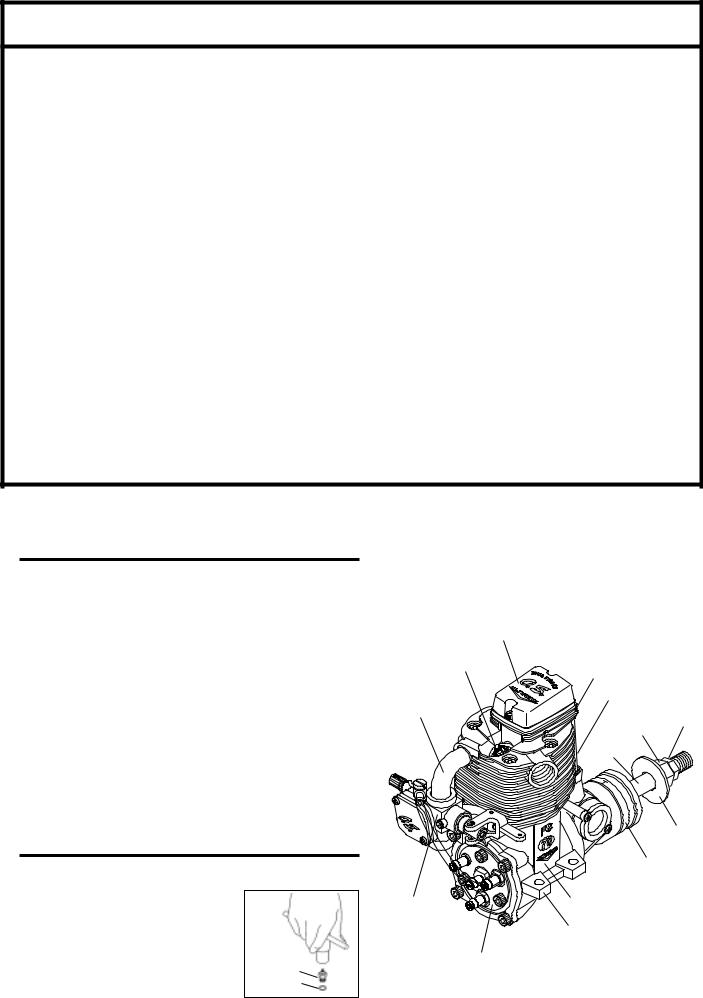
 NOTES
NOTES
 Take care that the glow plug clip or battery leads do not come into contact with the propeller. Also check the linkage to the throttle arm. A disconnected linkage could also foul the propeller.
Take care that the glow plug clip or battery leads do not come into contact with the propeller. Also check the linkage to the throttle arm. A disconnected linkage could also foul the propeller.
 After starting the engine, carry out any needle-valve readjustments from a safe position behind the rotating propeller. Stop the engine before attempting to make other adjustments to the carburetor.
After starting the engine, carry out any needle-valve readjustments from a safe position behind the rotating propeller. Stop the engine before attempting to make other adjustments to the carburetor.
 Adjust the throttle linkage so that the engine stops when the throttle stick and trim lever on the transmitter are fully retarded. Alternatively, the engine may be stopped by cutting off the fuel supply. Never try to stop the engine physically.
Adjust the throttle linkage so that the engine stops when the throttle stick and trim lever on the transmitter are fully retarded. Alternatively, the engine may be stopped by cutting off the fuel supply. Never try to stop the engine physically.
 Take care that loose clothing (ties, shirt sleeves, scarves, etc.) do not come into contact with the propeller.
Take care that loose clothing (ties, shirt sleeves, scarves, etc.) do not come into contact with the propeller.
Do not carry loose objects (such as pencils, screwdrivers, etc.) in a shirt pocket from where they could fall through the propeller arc.
 Do not start your engine in an area containing loose gravel or sand. The propeller may throw such material in your face and eyes and cause injury.
Do not start your engine in an area containing loose gravel or sand. The propeller may throw such material in your face and eyes and cause injury.
 For their safety, keep all onlookers (especially small children) well back (at least 20 feet or 6 meters) when preparing your model for flight. If you have to carry the model to the take-off point with the engine running, be especially cautious. Keep the propeller pointed away from you and walk well clear of spectators.
For their safety, keep all onlookers (especially small children) well back (at least 20 feet or 6 meters) when preparing your model for flight. If you have to carry the model to the take-off point with the engine running, be especially cautious. Keep the propeller pointed away from you and walk well clear of spectators.
 Warning! Immediately after a glowplug-ignition engine has been run and is still warm, conditions sometimes exist whereby it is just possible for the engine to abruptly restart if the propeller is casually flipped over compression WITHOUT the glowplug battery being reconnected. Remember this if you wish to avoid the risk of a painfully rapped knuckle!
Warning! Immediately after a glowplug-ignition engine has been run and is still warm, conditions sometimes exist whereby it is just possible for the engine to abruptly restart if the propeller is casually flipped over compression WITHOUT the glowplug battery being reconnected. Remember this if you wish to avoid the risk of a painfully rapped knuckle!
4
INTRODUCTION
The FS-70 ULTIMATE comes equipped with the new O.S. FS70U diaphragm type fuel pump and matching Type 60U carburetor incorporating a built-in pressure regulator. These features ensure that fuel/air mixture strength is maintained at a constant level through maneuvers, for consistent performance and reliable throttle response.
In the interests of improved durability, certain ferrous parts that are particularly susceptible to corrosion in four-stroke engines, have a corrosion resistant plating and, for the same reason, a special grease-packed twin-sealed rear ball-bearing is used.
To maintain the four-stroke engine's reduced noise levels, the FS-70 ULTIMATE is supplied with an O.S. Type F-4020 baffled silencer (muffler) of substantially enlarged volume, as standard equipment.
Where installation calls for a separate exhaust pipe, these parts are available as optional extras.
INSTALLING THE GLOW PLUG
Carefully insert plug, with washer, fingertight only, before final tightening with the correct size plug wrench.
Glow plug
Washer
Rocker Cover
Glow plug Type F
Cylinder Head
Push Rod Cover
Intake Pipe
Lock Nut
Propeller Nut
Crankshaft
Propeller Washer
Drive Hub
Carburetor |
Crankcase |
Type 60U |
|
|
Beam Mount |
|
Pump Unit (FS-70U) |
5
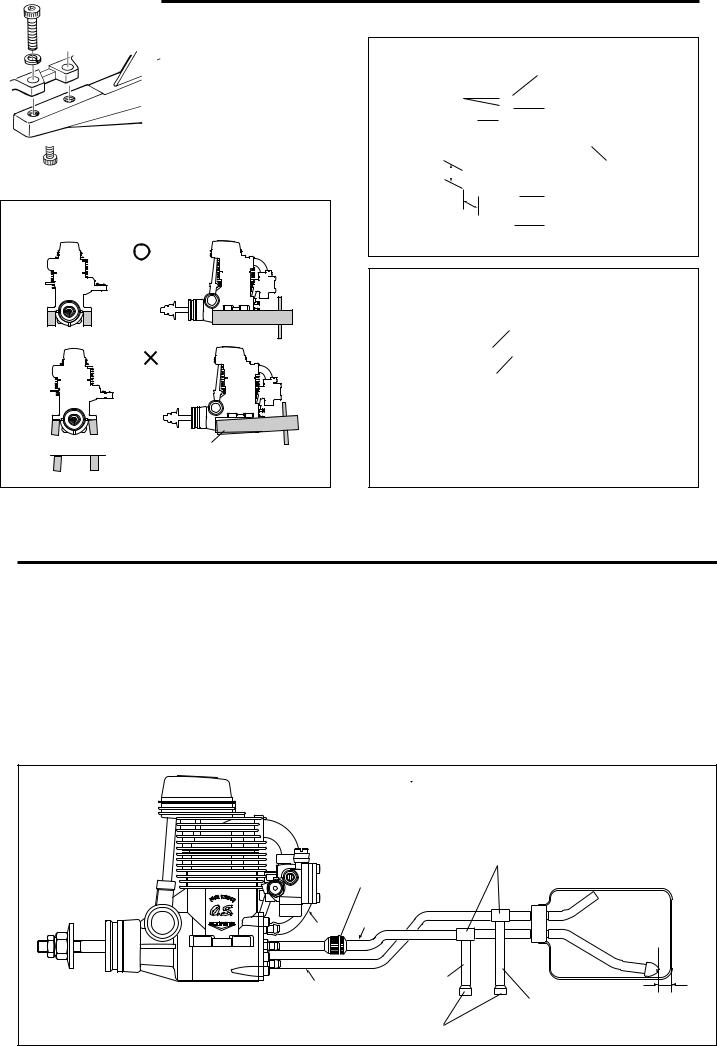
INSTALLATION
Because the FS-70 ULTIMATE is a powerful, largedisplacement, single-cylinder four-stroke-cycle engine, it is essential to use very substantial engine mounting. Conventional wooden mounting beams should be of rigid hardwood and of at least 15mm or 5/8-in square section.
Make sure that these mounting beams are accurately aligned and firmly integrated with the airframe, reinforcing the adjacent structure to absorb vibration. Use 3mm or larger steel screws, preferably Allen type hexagon socket head cap screws, with washers and locknuts, for bolting the engine to the bearers.
Make sure that the mounting beams are parallel and that their top surfaces are in the same plane.
|
CORRECT |
|
|
|
Top surfaces are |
Side view |
|
Front view |
in the same plane. |
||
|
INCORRECT
Top surfaces are not |
Opposite beam |
in the same plane. |
Top surfaces are not in the same plane. |
|
|
|
Engine does not rest firmly. |
Re-align the surfaces as necessary |
|
How to fasten the mounting screws.
Hardwood mounting beams
Tighten second nut firmly
.
3mm steel nuts
first.
Spring washer lock washer
15mm min. |
|
|
Hardwood such as |
|
|||
15mm min |
or maple. |
||
|
|||
Radial motor mount (cast aluminum)
6
FUEL TANK & LINES
 A fuel tank of approximately 300cc capacity is suggested. This allows up to 12-13 minutes flying time, dependent upon the type of fuel used, the size of the propeller and on the proportion of full-throttle to part-throttle operation through the flight.
A fuel tank of approximately 300cc capacity is suggested. This allows up to 12-13 minutes flying time, dependent upon the type of fuel used, the size of the propeller and on the proportion of full-throttle to part-throttle operation through the flight.
 To prevent the pickup from adhering to the tank wall under suction and restricting fuel flow, slots may be filed in the end of the weight as shown. Alternatively, a Non-Bubble type weight (Code No. 71531000) may be used.
To prevent the pickup from adhering to the tank wall under suction and restricting fuel flow, slots may be filed in the end of the weight as shown. Alternatively, a Non-Bubble type weight (Code No. 71531000) may be used.
 Make sure that the tank is well rinsed out with methanol or glow fuel before installation and that the pickup weight is well clear of the bottom of the tank when held vertically (see sketch).
Make sure that the tank is well rinsed out with methanol or glow fuel before installation and that the pickup weight is well clear of the bottom of the tank when held vertically (see sketch).
 Since high pressure is applied to the fuel tank from the engine crankcase, use a thick-walled strong enough tank and securely seal the area around the cap.
Since high pressure is applied to the fuel tank from the engine crankcase, use a thick-walled strong enough tank and securely seal the area around the cap.
Fuel filter - Do not use a felt type filter.
T nipples (sold separately)
|
Fuel filter (sold separately) |
B |
A |
JAPAN |
|
|
Fuel |
C |
supply line |
10-15mm
Tank pressure vent line
Caps (sold separately)
7
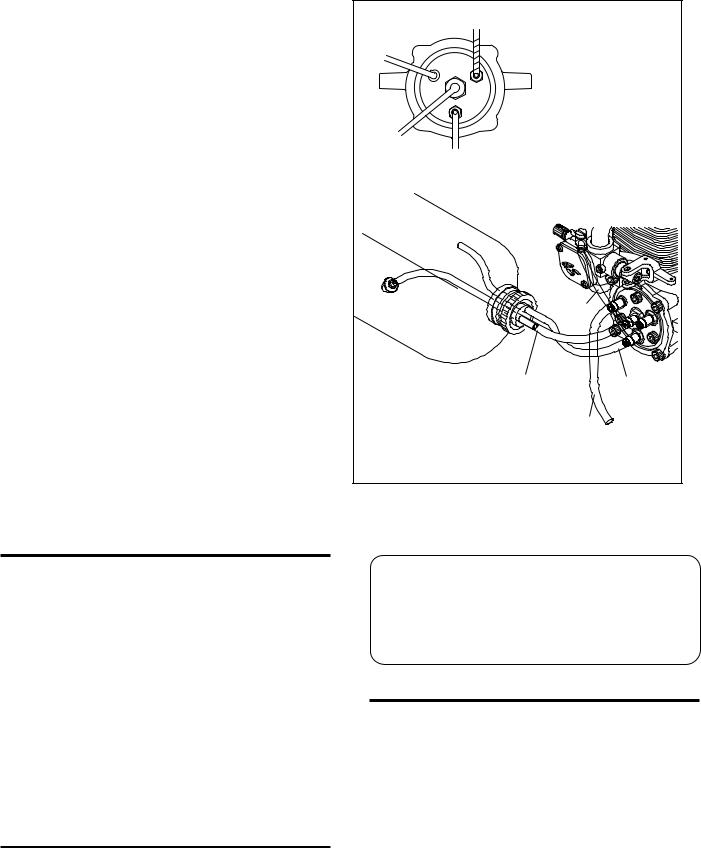
 Make connections using a commercially available thickwalled silicone tubing of approximately 2.5mm bore and 5.0mm outside diameter. It is suggested that tube clips be used at all connections.
Make connections using a commercially available thickwalled silicone tubing of approximately 2.5mm bore and 5.0mm outside diameter. It is suggested that tube clips be used at all connections.
The function of the various tubing connected to the engine and tank (see sketch) are as follows:
Line A: To draw fuel from tank to pump (IN)
Line B: To deliver fuel from pump to carburetor (OUT)
Line C: To pressurize fuel tank.
Line D: Air intake pipe to take air into the crankcase, not a breather. Be careful not to let the dirt and dust in. Tube length should be less than 150mm.
Important
Lines B is already installed when the engine is shipped from the factory. If any of these lines should need to be replaced, due to damage or installation problems, be sure to use tubing of the same dimensions and quality as the originals. The length of Line B is approx 65mm.
Note: Since the FS-70 ULTIMATE has a positively pumped fuel supply, it does NOT require muffler pressurization.
8
EXHAUST HEADER PIPE & SILENCER
Install these in the following sequence.
Screw the header pipe into the cylinder head until it " bottoms ", then unscrew sufficiently to achieve the desired exhaust angle and tighten the locknut securely with a 14mm wrench. Screw the silencer onto the outer end of the header pipe and tighten the other locknut.
The application of a heatproof silicone sealant to the threads of the exhaust system is recommended to reduce the risk of joints loosening and the leakage of exhaust gases and oil residue.
Reminder:
Model engines generate considerable heat and contact with the header pipe or silencer may result in a serious burn.
If you need to tighten the silencer joints, which may loosen when they are hot, use a thick folded cloth for protection.
THROTTLE LINKAGE
Before connecting the throttle to its servo, make sure that the throttle arm and linkage safely clear any adjacent part of the airframe structure, etc., as the throttle is opened and closed.
Connect the linkage so that the throttle is fully closed when the transmitter throttle stick and its trim lever are at their lowest settings and fully open when the throttle stick is in its fully-open position..
Carefully align the appropriate holes in the throttle arm and servo horn so that they move symmetrically and smoothly through their full travel.
B
D
A
C
B
AC
D
Be sure to put the end of the pipe outside the fuselage for air intake.
Note:
The engine is equipped a slide valve carburetor which has a narrower movement between fully closed and fully open. Secure the throttle lever linkage so that it may not move with vibration.
NEEDLE-VALVE EXTENSION
The needle-valve supplied with this engine is designed to incorporate an extension so that, when the engine is enclosed within the fuselage, the needle-valve may be adjusted from the outside.
Cut a commercially available rod to the required length, bend one end to an L shape, insert it into needle's center hole and secure it by tightening the set-screw in the needle-valve knob with 1.5mm Allen key.
Needle Valve Extension Cable Set (Code No. 72200080) is available from O.S. as an optional part.
9
